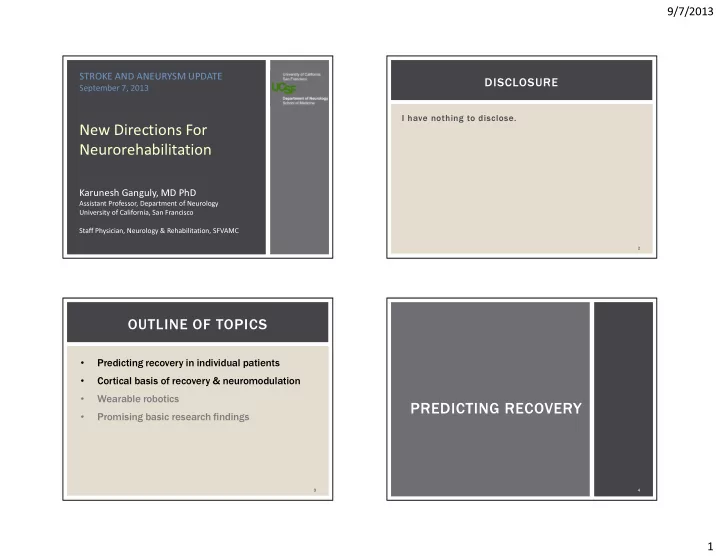

9/7/2013 STROKE AND ANEURYSM UPDATE DISCLOSURE September 7, 2013 I have nothing to disclose. New Directions For Neurorehabilitation Karunesh Ganguly, MD PhD Assistant Professor, Department of Neurology University of California, San Francisco Staff Physician, Neurology & Rehabilitation, SFVAMC 2 OUTLINE OF TOPICS • Predicting recovery in individual patients • Cortical basis of recovery & neuromodulation • Wearable robotics PREDICTING RECOVERY • Promising basic research findings 3 4 1
9/7/2013 POTENTIAL FOR RECOVERY TMS General characteristics at population level TMS • Age EMG Recording • Infarct size & location • Acute treatment regimen TMS • Medical co-morbidities stimulus Amplitude (mV) 1 artifact MEP Exam findings • Independent digit movements • Shoulder movements • Ankle dorsiflexion -1 MEP What about predicting recovery for individual patients? -10 0 50 Time (ms) • Multimodal assessment shows promise (exam, TMS, MRI) • Predicting Recovery Potential (PREP) algorithm (Stinear et al., TMS = Transcranial Magnetic Stimulation Brain, 2012) MEP = Motor Evoked Potential 5 6 MULTIMODAL ASSESSMENTS TO PREDICT RECOVERY MULTIMODAL ASSESSMENTS TO PREDICT RECOVERY SAFE Score ≥ 8, Complete recovery PREP Algorithm ARAT • • 40 patients with stoke Grasp (6) • (cortical & subcortical) < 8 Grip (4) • assessed at day 3 and Pinch (6) • reevaluated at 3 months Gross (3) TMS MEP +; Notable recovery • SAFE (Shoulder Abduction Items used… & Finger Extension) Score MEP Negative • TMS & MEP • DWI MRI (-); Limited MRI Diffusion Asymmetry Index (+); None Stinear et al., Brain 2012 Adapted from Stinear et al., Brain 2012 8 2
9/7/2013 NEURAL BASIS FOR RECOVERY ARM FUNCTION REPAIR MECHANISMS - Growth factors fMRI activity fMRI activity - GABA receptor - Angiogenesis CORTICAL BASIS FOR - Inflammation - Dendritic branching glial reaction glial reaction RECOVERY & - Axonal Sprouting - Cell-cycle proteins - Excitability NEUROMODULATION synaptogenesis synaptogenesis O Week 8 O Week 8 Ipsilesional Contralesional Hemisphere Hemisphere 9 Adapted from Cramer, Ann Neurol , 2008 IMBALANCE OF INHIBITION NON-INVASIVE NEUROMODULATION Imbalance of inter-hemispheric inhibition - - - - + + + + + + + + - - - - + + + + - - - - + + + + - - - - High-frequency Low-frequency (> 3Hz) rTMS (1 Hz) rTMS Rheme et al., 2011 Ward and Grefkes, 2013 11 12 3
9/7/2013 NEUROMODULATION WITH R-TMS META-ANALYSIS OF TMS TRIALS • 48 patients, randomized into 3 groups • Studies (n=18) Sham, 3Hz and 10 Hz rTMS of affected hemisphere • Small studies with ~10 patients from 2005-2012 • 5 days of stimulation at 130% of UH rest MEP • Rehab regimen? • Randomized but not blinded Khedr et al., 2010 • 1 Hz rTMS over the unaffected hemisphere (n=8) or HFS rTMS to affected hemisphere • Outcome measures were variable • Minimal adverse effects (HA, fatigue) • Subgroup analysis favored 1Hz rTMS over the Hsu et al., Stroke 2012 unaffected hemisphere 4=Moderate Severe; Dependent on ADLs; Unable to walk 13 1=No significant disability; Able to perform usual tasks NEUROANATOMICAL BASIS FOR TMS RESPONSE • 29 patients (16 subcortical, 13 cortical involvement) • Single dose of 10Hz (5s/25s for 20x over ~6 min) • 30% increase in speed of finger and hand taps for subcortical only WEARABLE ROBOTS Ameli et al., Ann Neurol, 2009 15 16 4
9/7/2013 ‘WEARABLE’ ROBOTS INNOVATIVE BASIC SCIENCE Rosen Lab (UCSC) Ekso bionics Univ. Washington 18 PROMISING BASIC RESEARCH CONCLUSION Pharmacological modulation of perilesional inhibition • Decades of basic research has built a foundation for • Clarkson et al., Nature 2010 evaluating and developing new treatments • Blockade of extrasynaptic GABA-R improved motor recovery • Individualized predictive models and treatment plans seem quite feasible Modulation of molecules that inhibit axon sprouting • Ongoing research should help develop and refine • NOGO Receptor (Li et al., 2010) specific approaches to rehabilitation • Ephrin Receptor (Overman et al., 2012) • Neuromodulation via stimulation is very promising • Recent reports of innovative approaches suggest new treatment options 19 20 5
Recommend
More recommend